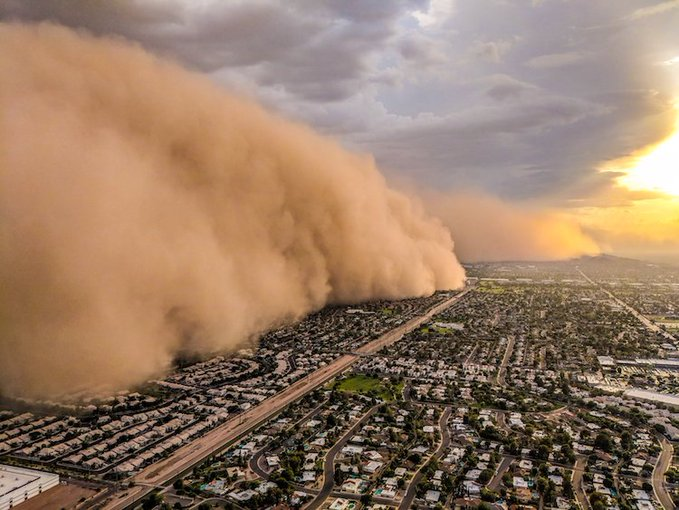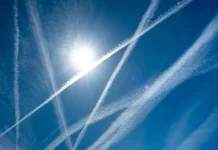
Two dust storms converged over the greater Phoenix area on Sunday, hours after the city broke another record as a heat wave grips the West.
Yes! It’s not everyday we can watch two dusty outflows collide south of downtown Phoenix.
Not everyday we can watch two dusty outflows collide south of downtown Phoenix from our office cam. #azwx pic.twitter.com/UrSk7YiKdA
— NWS Phoenix (@NWSPhoenix) August 17, 2020
The National Weather Service (NWS) Phoenix office said that the city beat the previous record-high temperature of 113 degrees Fahrenheit on Sunday, topping out at 115 degrees.
But hours later, thunderstorms developed that triggered dust storms across parts of the area.
Haboob pic.twitter.com/XZrLaD8B7N
— Vin Boz (@vinboz) August 17, 2020
The action began approaching the Valley around 5:30 p.m., whenthe area along Interstate 10 south of Phoenix was slammed with blowing dust.
“Winds are creating areas of blowing dust elsewhere in the Phoenix area,” forecasters said.
Just before 6 p.m., the NWS issued a dust advisory for “a wall of dust” moving south across parts of the area at 40 mph, before issuing a dust storm warning for Maricopa and Pinal Counties.
The forecast office said that visibility fell to zero miles at Sky Harbor International Airport.
Current view from our office with less than 1/4 mi visibility. Sky Harbor briefly fell to 0 miles. Please remain careful and vigilant on the roads the next couple of hours! #azwx pic.twitter.com/DVsoiMYsyR
— NWS Phoenix (@NWSPhoenix) August 17, 2020
Drivers throughout the area were forced to pull over to stay safe from roads with low visibility. A semi-truck on Interstate 10 near Picacho Peak was blown over by its side during the storm, resulting in the roadway being closed for a short period.
I-10 reopened near Picacho Peak around 7 p.m., but rain and dust continued to affect drivers on the freeway west of Phoenix.
Dust advisories for several counties remained in effect on Sunday night, according to the NWS.
Haboob approaching Gila Bend. #azwx pic.twitter.com/Zgpx0e3xrL
— Lori Grace Bailey (@lorigraceaz) August 17, 2020
The NWS said that dust storms and haboobs can occur anywhere in the U.S. but are most common in the Southwest. They are a result of thunderstorm winds.
In the Southwest, these types of storms are “relatively common” during the North American Monsoon Season, which is an increased period of thunderstorms and rainfall from July through September.
This is the view on I-10 WB right now near Picacho Peak. #PullAsideStayAlive when a dust storm comes into an area. Get tips here: https://t.co/X2sLfWwAV5#azwx #aztraffic #I10 pic.twitter.com/TBJfm0oXFK
— Arizona DOT (@ArizonaDOT) August 17, 2020
Dust storms present the biggest threat to motorists, as the advancing wall of dust and debris may be miles long and several thousand feet high.
Since dust storms strike with little warning, they can make driving conditions especially hazardous.
More dust photos from I-17 in Phoenix …#azwx #I17 #phxtraffic pic.twitter.com/b0jB3Sxjga
— Arizona DOT (@ArizonaDOT) August 17, 2020
“Blinding, choking dust can quickly reduce visibility, causing accidents that may involve chain collisions, creating massive pileups,” according to the NWS. “Dust storms usually last only a few minutes, but the actions a motorist takes during the storm may be the most important of his or her life.“
A few views from last nights #haboob in #Phoenix. Haboobs are giant walls of #dust created from #highwinds rushing out of a collapsing #thunderstorm. Cold air rushes down at a high rate, picking up massive amounts of dust. Photos courtesy Bryan Neumeister #weatherfront pic.twitter.com/F6nwvPoRpt
— City of Phoenix, AZ (@CityofPhoenixAZ) August 17, 2020
The record heat across the West over the weekend, including in Death Valley, which recorded 130 degrees on Sunday, is expected to carry into this week with little to no relief in sight.
More apocalyptic dust storms on Strange Sounds and Steve Quayle.
Now if you are looking for supplements to increase your healthy lifestyle please visit Natural Health Source.













I’m so tired of all the lying and hype we’re being fed. Only one sentence in this entire article was accurate:
“In the Southwest, these types of storms are “relatively common” during the North American Monsoon Season, which is an increased period of thunderstorms and rainfall from July through September.”
All the rest of this article is fluff and hype. I grew up in the Phoenix area. Huge dust storms like shown herein were quite common in the 1960s and early 1970s when there was much more agriculture near the city’s edges. At least one dust/rainstorm a week would blow through from mid-July through mid-September. Another thing that’s quite common is 113°F summer temperatures in the Phoenix area. Usually the highest temperatures were around the 4th of July, because that was when it was the driest. By mid-August, the afternoon rainstorms (more dust than water) would typically bring the recorded peak temperatures down a few degrees. The fact that the temperature hit 113° before being brought down by the monsoon storm is only a timing anomaly.
Regarding the touted terrible danger to motorists, anyone who has lived in that area for more than a year would know to pull as far off the road as safely possible, stop, turn OFF their automatic lights, and make sure their foot wasn’t resting on the brake pedal.
From the time one can see a thin brown line on the horizon to the time one is engulfed in dust is usually less than ten minutes, and a faster-moving storm will set upon you much quicker. So, if you see a thin brown line on the horizon and clouds over it, have enough sense to pull off the road and make sure you don’t have any lights showing to the rear of your vehicle. Once visibility is near-zero, if you have lights showing to the rear, a moving vehicle is likely to pull in behind you thinking s/he will follow your lights to safety. Then, *crash* – hence the importance of no lights during the dust storm.
Please return perspective and level-headed thinking to news reporting.
Well , my most of predictions came through yet we are in the middle of months? i said the death tool from virus will 170K or more it is already. I said quakes of 6.9 in Philippines. and much of my predictions are documented here. You all be Judge indeed. Dutchinse he let it happens and make predictions based on where it is ?